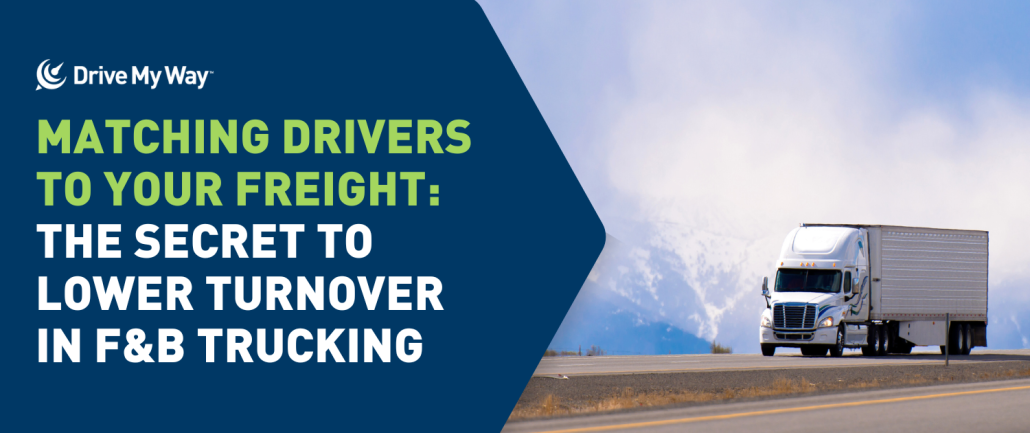
For food and beverage carriers, driver turnover is more than an HR issue. It can be a direct hit to service, sales, and profitability.
With the physical demands of touch freight, specialized endorsements, and unconventional schedules, F&B trucking has some of the highest barriers to entry in the industry, making recruiting and retaining drivers a constant challenge.
However, many carriers overlook one of the simplest solutions: matching the right driver to the right freight from the very start. When carriers align job realities with driver preferences and capabilities, turnover rates fall, job satisfaction rises, and the talent pipeline gets stronger.
Keep reading to find out how matching drivers to freight can solve some of the toughest pain points in F&B trucking.
The Physical Demands: Finding Drivers Who Can Handle Touch Freight
F&B routes often require drivers to unload cases with dollies, climb stairs, and walk products into restaurants or retail stores. This level of physical activity can be a deal-breaker for many drivers, and a quick path to burnout if they weren’t prepared for it.
When carriers are transparent about these requirements upfront and target candidates who are open to physical, hands-on work, they avoid hiring drivers who might quit after a week. Pre-screening for willingness to handle touch freight can help you narrow the applicant pool and ensure the drivers you hire are more likely to stay.
Specialized Endorsements: Eliminating Qualification Bottlenecks
Refrigerated trailers, bulk liquids, and certain specialty items require endorsements like a tanker or hazmat endorsement to transport food grade materials. Since fewer drivers carry these certifications, carriers often waste time interviewing candidates who won’t be able to move the freight.
By matching job listings with drivers who already hold the required endorsements, you can cut down on delays, prevent idle equipment, and reduce missed delivery deadlines. It also positions your fleet as professional and organized, which are qualities that appeal to drivers who want to invest in a long-term career.
Scheduling Realities: Reducing Mismatched Expectations
F&B drivers often start their days at 2 or 3 a.m., deliver on weekends, or run through holidays. These schedules can be a deal-breaker for drivers seeking a more traditional work-life balance.
Misaligned expectations around scheduling are one of the fastest ways to drive turnover. By capturing schedule preferences early and ensuring drivers know what the job entails, you can avoid mismatches that lead to no-shows and resignations.
Urban, Multi-Stop Deliveries: Matching Route Experience with Skill Sets
Delivering to congested urban centers with multiple stops requires a special set of skills, and lots of patience. Drivers who thrive on long-haul open-road work may struggle with city congestion and tight delivery windows.
By identifying drivers who prefer local or regional work, who enjoy customer interaction, and who have prior experience in urban delivery, carriers set their fleets up for success. Drivers who are matched to routes that fit their strengths are less likely to churn and more likely to deliver consistent performance.
Customer Service as a Hiring Priority
In F&B trucking, drivers are more than freight movers. They are the face of your brand to restaurant managers, grocery clerks, and retail staff. Poor customer service at the delivery dock can damage relationships and even cost accounts.
That’s why matching should also take customer service skills into account. Hiring drivers who are personable, communicative, and customer-oriented ensures positive interactions, fewer complaints, and stronger client relationships.
Competing with “Easier” Driving Jobs
One of the toughest challenges in F&B trucking is competing with jobs that offer comparable pay along with easier freight handling and more predictable schedules. Drivers often leave for these positions, viewing them as less strenuous than the demands of F&B work.
Instead of fighting this reality, carriers can sharpen their recruiting efforts by clearly positioning F&B roles to the right audience. Advertising that emphasizes steady routes, consistent demand, and the chance to stay active on the job helps attract drivers who value those aspects.
By tailoring job postings and outreach to drivers who are a natural fit for this work, you can strengthen retention and avoid wasting resources on mismatched candidates.
Seasonal Spikes: Building a Proactive Talent Pipeline
The F&B sector experiences some seasonal swings, such as seasonality by produce type, beverage spikes in summer, or holiday food demand towards the end of the year. Many carriers scramble to recruit drivers at the last minute, lowering candidate quality and hurting delivery performance.
A better approach is maintaining an ongoing relationship with qualified drivers year-round. By keeping a warm pipeline of pre-matched candidates, carriers can ramp up quickly during peak demand without sacrificing quality.
The Bottom Line: Matching Is Retention
The cost of turnover in F&B trucking goes far beyond recruiting spend, it includes lost sales, disrupted customer relationships, and wasted training investments. Matching drivers to the right freight lays the foundation for stronger retention.
By aligning drivers’ physical abilities, endorsements, scheduling preferences, route experience, and customer service skills with the realities of your freight, carriers can lower turnover, improve service, and build a more loyal workforce.
For more ways to stay ahead of the curve in the transportation industry in 2025, be sure to check out the rest of our Employer Blog posts and connect with us on social media.


